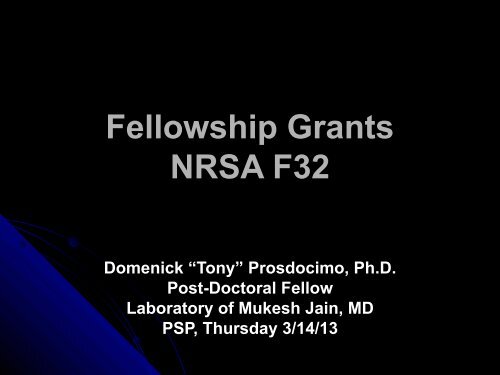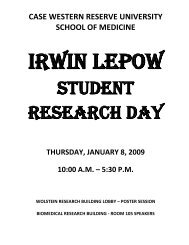Fellowship Grants NRSA F32
Fellowship Grants NRSA F32
Fellowship Grants NRSA F32
Create successful ePaper yourself
Turn your PDF publications into a flip-book with our unique Google optimized e-Paper software.
<strong>Fellowship</strong> <strong>Grants</strong><br />
<strong>NRSA</strong> <strong>F32</strong><br />
Domenick “Tony” Prosdocimo, Ph.D.<br />
Post-Doctoral Fellow<br />
Laboratory of Mukesh Jain, MD<br />
PSP, Thursday 3/14/13
Experimental<br />
design<br />
Mentor’s advice<br />
Letters of<br />
recommendation<br />
Pilot data<br />
Goal setting<br />
<strong>Fellowship</strong> Toolbox:<br />
Where to look<br />
For fellowships<br />
Why a fellowship<br />
What budget<br />
can be used for<br />
Write a<br />
Compelling story<br />
Peer advice
The first steps toward a fellowship?<br />
1. Pre-doc: identify mentor with track record of training in your<br />
field of interest<br />
2. Post-doc:<br />
- Preliminary data.<br />
- Identify local and national collaborators<br />
- need 6-8 week block of time to write<br />
- appointment status – “post-doctoral scholar”<br />
- application deadlines<br />
3. A successful fellowship application focuses not only on the<br />
science, but also the training involved<br />
4. Acquire previously funded applications as a roadmap<br />
- email me, dap17@case.edu
• National Research Service Awards (<strong>NRSA</strong>)<br />
– F30 Predoctoral Awards for MD/PhD <strong>Fellowship</strong>s<br />
– F31 Predoctoral <strong>Fellowship</strong>s<br />
– <strong>F32</strong> Postdoctoral <strong>Fellowship</strong>s<br />
• K Awards<br />
– K01 Mentored Research Scientist Development Awd<br />
– K08 Mentored Clinical Scientist Development Award<br />
– K23 Mentored Patient-Oriented Research<br />
Career Development Award<br />
– K99/00 Pathway to Independence Award
Grantwriting Resources<br />
ScienceCareers.org<br />
Career Development Articles<br />
NIMH Grant Application Process<br />
http://www.nimh.nih.gov/researchFunding/grantprocess.cfm<br />
http://www.nimh.nih.gov/researchFunding/training.cfm<br />
FASEB <strong>Grants</strong>manship Training Program<br />
https://ns2.faseb.org/careerutilities/grantprg.htm<br />
Grant Application Writer’s Handbook, Reif-Lehrer<br />
See also http://casemed.case.edu/gradprog/
The NIH <strong>NRSA</strong> Ruth L Kirschstein<br />
F KIOSK<br />
http://grants1.nih.gov/training/F_files_nrsa.htm<br />
Stipend FY 2012<br />
Predoctoral $22,032<br />
Postdoctoral Years of Experience:<br />
0 $39,264<br />
1 $41,364<br />
2 $44,340<br />
3 $46,092<br />
Training Related Expenses<br />
Predoctoral Trainees: $4,200<br />
Postdoctoral Trainees: $7,850
Ruth L. Kirschstein National Research Service Awards (<strong>NRSA</strong>) for Individual<br />
Postdoctoral Fellows (Parent <strong>F32</strong>) (PA-10-110)National Institutes of HealthNational<br />
Center for Complementary and Alternative MedicineNational Cancer InstituteNational<br />
Center for Research ResourcesNational Eye InstituteNational Human Genome Research<br />
InstituteNational Heart, Lung, and Blood InstituteNational Institute on AgingNational<br />
Institute on Alcohol Abuse and AlcoholismNational Institute of Allergy and Infectious<br />
DiseasesNational Institute of Arthritis and Musculoskeletal and Skin DiseasesNational<br />
Institute of Biomedical Imaging and BioengineeringEunice Kennedy Shriver National<br />
Institute of Child Health and Human Development National Institute on Drug Abuse<br />
National Institute on Deafness and Other Communication DisordersNational Institute of<br />
Dental and Craniofacial ResearchNational Institute of Diabetes and Digestive and<br />
Kidney DiseasesNational Institute of Environmental Health SciencesNational Institute of<br />
General Medical SciencesNational Institute of Mental HealthNational Institute of<br />
Neurological Disorders and StrokeNational Institute of Nursing Research
The <strong>NRSA</strong> (F31, <strong>F32</strong>) success rate<br />
http://report.nih.gov/nihdatabook/index.aspx?catid=17
SA Application Preparation<br />
low the instructions:<br />
dividual <strong>Fellowship</strong> SF424 (R&R) Application Guide”<br />
1. Submission is three times per year<br />
(Apr 8, Aug 8, Dec 8)<br />
2. Grant needs routed internally first, application should be<br />
complete in full at least 1 week prior to submission dates<br />
3. Allow yourself 6-8 weeks to prepare<br />
4. This is a 3 year grant: proposal should fit accordingly<br />
5. It’s about the training as much as the science
Take a look at potential reviewers:<br />
Center for Scientific Review (CSR)<br />
http://www.csr.nih.gov/committees/rosterindex.asp<br />
Roster Index for <strong>Fellowship</strong> Study Section<br />
http://public.csr.nih.gov/StudySections/<strong>Fellowship</strong>/Pages/default.aspx<br />
Physiology and Pathobiology of Cardiovascular and<br />
Respiratory Systems [ F10A ]
• Reviewers are:<br />
– Busy<br />
– Overworked<br />
Write for the Reviewers<br />
– May not be as<br />
knowledgeable about<br />
the details<br />
Typically, you’ll receive three reviewers:<br />
-each reviewer scores your grant on a 1-9 scale prior to study section.<br />
-the average gives an impact score<br />
The day your study section meets:<br />
-all reviewers of the study section will have access to the impact<br />
scores as well as the grant<br />
-typically, best scored grants will be discussed first<br />
-on average, each grant gets discussed for only 10 minutes<br />
-impact scores could change following discussion<br />
-final impact scores are translated into a percentile
Reviewer 1<br />
Reviewer 2<br />
Reviewer 3
The Application:<br />
Online: grants.gov - SF 424 (R&R)<br />
All subsequent sections are submitted as .pdf into this online<br />
submission form<br />
1. Project Summary / Abstract<br />
2. Project Narrative: 2-3 sentence paragraph summarizing<br />
your application in layman terms<br />
3. References Cited<br />
4. Facilities & Other Resources<br />
5. Equipment<br />
6. List of Referees: (identify 3 referees early)<br />
- 3 letters of reference submitted by the referee through<br />
eRA commons, you simply list the individuals name and<br />
affiliation.
The Application cont:<br />
7. Letters of Support: (identify potential collaborators<br />
early)<br />
- What techniques are outside the scope of your lab’s<br />
expertise<br />
- Be explicit in stating you will learn these techniques<br />
first-hand in your collaborators’ lab<br />
- remember, it’s more about the training than the<br />
science<br />
- be prepared to write these letters yourself and simply<br />
have your collaborator sign them
The Application cont:<br />
8. Statement by the mentor: (Critical)<br />
- A good letter should include:<br />
- Applicant accomplishments<br />
- Brief statement about applicant, undergrad and post-grad<br />
studies<br />
- how mentor came to know applicant<br />
- genesis of current application<br />
- current collaborations applicant has with other lab members<br />
- Mentor Training Record<br />
- brief background of mentor<br />
- list of past and present mentees (where are they now)<br />
- Research Training Plan for the Applicant<br />
- how often will mentor meet with applicant<br />
- present at local and national meetings<br />
- Relationship of training to career goals<br />
- how will the current application aid in developing an<br />
independent line of investigation
The Application cont:<br />
9. Biosketch:<br />
- Applicant<br />
- Personal statement, position and honors,<br />
Publications<br />
- Undergrad and post-graduate grades<br />
- Mentor
Get Started: The Research Idea<br />
A strong research idea should pass the “so what” test.<br />
What is the benefit of answering your question?<br />
Who will it help and how?<br />
If you cannot make a definitive statement about<br />
the purpose of your research, it is unlikely to be funded.
The Application cont:<br />
10. Specific Aims Page (1 page):<br />
- Brief overview/background<br />
- Hypothesis<br />
- Aims<br />
- helpful to include cartoon of hypothesis and aims
Specific Aims<br />
Goal - make the reviewer want to read more<br />
Make sure you:<br />
Provide a rationale—where did hypothesis come from?<br />
why is this a strong idea? is it novel?<br />
Have objectives that are measurable and highly focused<br />
Have aims that are feasible in technique, time and money<br />
-remember, this is a three year grant<br />
http://www.theresearchassistant.com/tutorial/2-1.asp
The Application cont:<br />
11. Research Strategy (6 pages):<br />
- Background and Significance<br />
- Approach / Preliminary Results<br />
- Aims<br />
- Rationale for subaims and proposed studies<br />
- Interpretation, Limitations, and Future Directions<br />
- Methods<br />
- Statistics
Questions thus far?
12. Use of Vertebrate animals:<br />
The Application cont:<br />
13. Select Agent Research:<br />
- are there hazardous or biological agents to be used to carry out<br />
proposed studies?<br />
14. Resource Sharing Plan<br />
- will the application result in the development of a new agent /<br />
mouse strain – NIH wants us to share<br />
15. Respective Contributions<br />
16. Selection of sponsor and institution<br />
- Why did you join the lab<br />
- how will the current application allow you to develop and<br />
independent line of investigation<br />
17. Responsible Conduct of Research
The Application cont:<br />
18. Goals for <strong>Fellowship</strong> Training and Career<br />
- short and long term goals<br />
- state how the current application will position you for Kgrant,<br />
R01 / independent line of investigation<br />
19. Activities Planned under this award<br />
- dedicated percent effort<br />
- what weekly research seminars will you attend<br />
- national meetings<br />
20. Doctoral Dissertation<br />
- 2 page summary of dissertation if applicable
Reviewer 1<br />
Reviewer 2<br />
Reviewer 3
Questions?

















